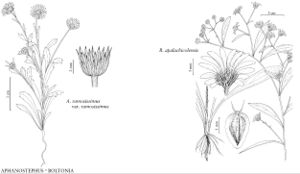Difference between revisions of "Boltonia apalachicolensis"
Syst. Bot. 12: 133, fig. 1. 1987.
FNA>Volume Importer |
FNA>Volume Importer |
||
| Line 47: | Line 47: | ||
|publication year=1987 | |publication year=1987 | ||
|special status= | |special status= | ||
| − | |source xml=https://jpend@bitbucket.org/aafc-mbb/fna-data-curation.git/src/ | + | |source xml=https://jpend@bitbucket.org/aafc-mbb/fna-data-curation.git/src/8f726806613d60c220dc4493de13607dd3150896/coarse_grained_fna_xml/V19-20-21/V20_818.xml |
|tribe=Asteraceae tribe Astereae | |tribe=Asteraceae tribe Astereae | ||
|genus=Boltonia | |genus=Boltonia | ||
Revision as of 15:27, 18 September 2019
Plants 50–180 cm; stolons and rhizomes absent, fallen stems frequently rooting at nodes. Stems erect. Leaf blades linear to oblanceolate, obovate, or oblique-elliptic; cauline 45–120 × 8–12 mm, bases not decurrent. Heads in corymbiform arrays, branches spreading to ascending, most bracts leaflike, 10–40 × 3–8 mm. Peduncles 6–35 mm; bracts (0–)1–3, linear to linear-oblanceolate, 1–2.5 mm. Involucres 2–2.5(–4) × 4–6 mm. Phyllaries in 2–4 series, linear to subulate, subequal, 0–4 merging down peduncle; outer 1.3–2 × 0.3–0.6 mm; inner 1.5–3 × 0.3–0.6. Ray florets 20–35; corollas white to lilac, laminae 5–9 mm, tubes 0.6–0.9 mm. Disc florets 80–134; corollas 2.1–2.9 mm. Cypselae obovoid, 1.3–2.1 × 0.8–1.3 mm, wings 0.2–0.3 mm wide; pappi awns 0.3–0.8 mm. 2n = 18.
Phenology: Flowering late Sep–Dec.
Habitat: Moist, gray sand, in semishade or deep shade, hardwood floodplain forests
Elevation: 0–10 m
Distribution

Fla., La., Miss.
Discussion
Selected References
None.
